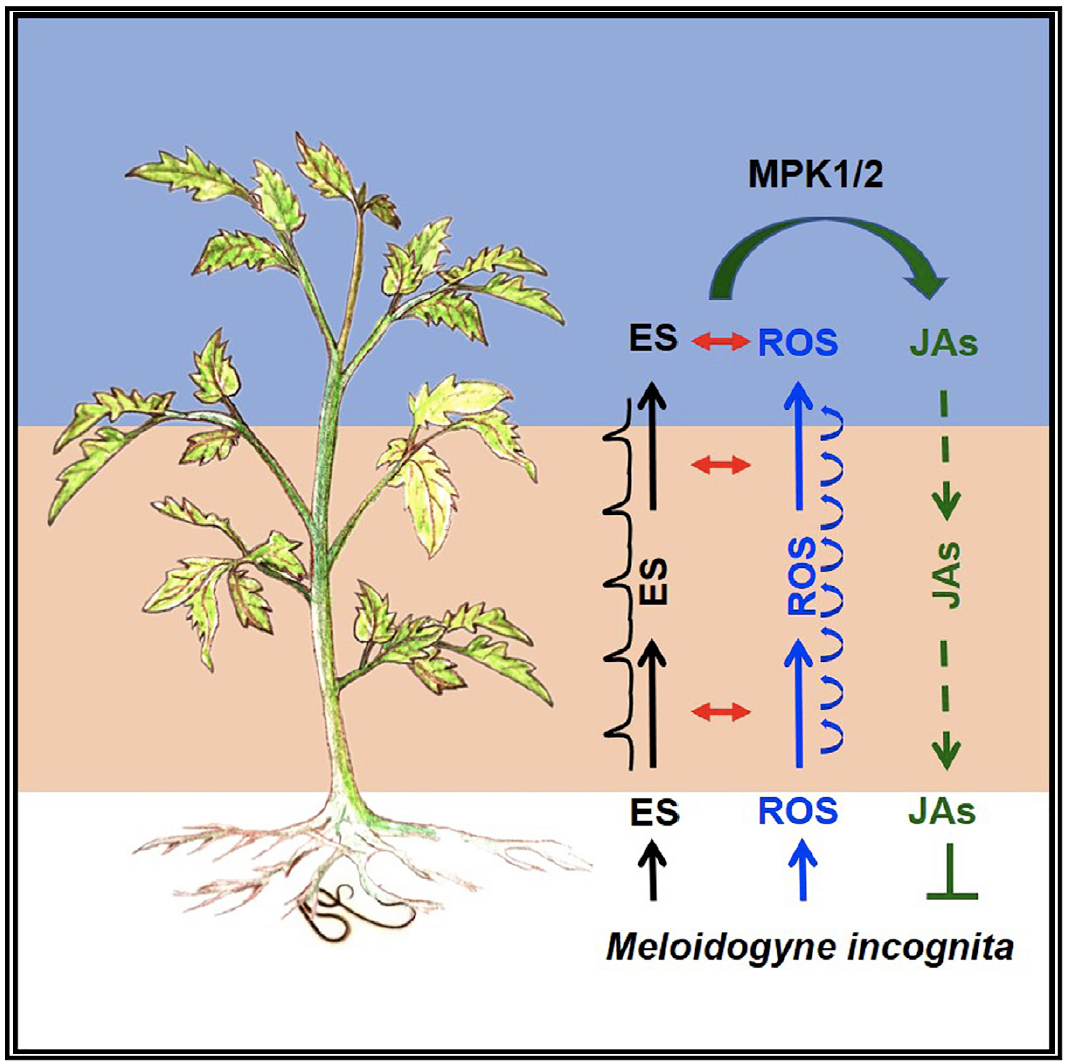博文
Current Biology:植物根-茎系统性信号转导介导根结线虫抗性
|||
Systemic Root-Shoot Signaling Drives Jasmonate-Based Root Defense against Nematodes
First author: Guoting Wang; Affiliations: Zhejiang University (浙江大学): Hangzhou, China
Corresponding author: Jingquan Yu
Shoot-root communication is crucial for plant adaptation to environmental changes. However, the extensive crosstalk between shoots and roots that controls the synthesis of jasmonates (JAs), in order to enhance defense responses against rhizosphere herbivores, remains poorly understood. Here, we report that the root-knot nematode (RKN) Meloidogyne incognita induces the systemic transmission of electrical and reactive oxygen species (ROS) signals from attacked tomato roots to the leaves, leading to an increased accumulation of JAs in the leaves. Grafting of 1.0-cm stem sections from mutants lacking GLUTAMATE RECEPTOR-LIKE 3.5 or the mutants deficient in RESPIRATORY BURST OXIDASE HOMOLOG 1 abolished the RKN-induced electrical signals and associated ROS and JA accumulation in the upper stems and leaves with attenuated resistance to RKN. Furthermore, the absence of systemic transmission of electrical and ROS signals compromised the activation of mitogen-activated protein kinases (MPKs) 1/2 in leaves. Silencing MPK1 or MPK2 abolished RKN-induced accumulation of JAs and associated resistance. These findings reveal a systemic signaling loop that integrates electrical, ROS, and JA signals to enhance the resistance in distal organs via root-shoot-root communication.

植物地上部分与根的通信对于植物适应环境的变化至关重要。然而,植物中茎与根之间有关调控茉莉酸JA的合成以增强植物对于根际草食动物防御响应的研究还存在很多空白。本文中,作者报道了根结线虫Meloidogyne incognita对于番茄根的啃食诱导了根向茎的系统性电传递和活性氧ROS信号,导致了叶片中的JA含量上升。将类谷氨酸受体基因GLR3.5功能突变或呼吸爆发氧化酶同系物基因RBOH1功能缺陷突变体的约1厘米茎嫁接到野生型上,根结线虫诱导的上层茎组织中电信号以及相关的ROS和JA积累均消失,并且叶片对于根结线虫也不再具有抗性。此外,因为缺少系统性的电信号和ROS信号传递会导致叶片中丝裂原活化蛋白激酶MPK1/2的激活同样受到影响。沉默MPK1或者MPK2基因会导致根结线虫诱导的JA积累和相关抗性失效。本文的发现揭示了一个整合了电、ROS以及JA信号的系统性信号转导回路,通过根-茎-根之间的通信来增强植物末端器官的抗性。
通讯:喻景权 (https://www.bioss.uni-freiburg.de/prof-andreas-hiltbrunner/)
个人简介:1979-1983年,浙江农业大学,学士;1988-1991年,日本国岛根大学,硕士;1991-1994年,日本国鸟取大学,博士;1994-1995年,日本国岛根大学,博士后。
研究方向:从事蔬菜等园艺植物生长发育与产品安全调控机制的研究。
doi: https://doi.org/10.1016/j.cub.2019.08.049
Journal: Current Biology
Published date: October 03, 2019

https://blog.sciencenet.cn/blog-3158122-1201405.html
上一篇:Nature:2011年背靠背发表的植物感知氧气浓度分子机制
下一篇:Nature Plants:拟南芥根组织维管形成层的转录调控网络
全部作者的其他最新博文
- • Plant Physiology:CsMADS3促进柑果中的叶绿素降解和类胡萝卜素合成(华中农业大学)
- • Molecular Plant:LBD11-ROS反馈调节作用于拟南芥的维管形成层增殖和次生生长(浦项科技大学)
- • Science Advances:根结线虫通过调控植物的CLE3-CLV1模块,促进侵染进程(日本熊本大学)
- • Nature Communications:油菜素内酯参与植物营养生长期转变的分子机制解析(浙江农林大学)
- • Current Biology:光合作用产生的蔗糖驱动侧根“生物钟”(德国弗莱堡大学)
- • PNAS:花同源异型基因在叶中被抑制、花中被激活的分子机制(南卡罗来纳大学)